|
How to
Balance the Engine for Less Vibration An imbalance in the crankshaft in relation to the reciprocating weight of the upper end causes vibration and a loss of power. Making sure your engine is balanced correctly is essential, especially if you are modifying the engine to work in a different rpm range than what it was designed for. Using a lighter wrist pin can help if the vertical forces are too much. When the piston goes to TDC and then is pulled back down by the crank, the force on the crankshaft is towards the cylinder head because that changing of direction creates a force of inertia upwards. Put any weight on a string and throw it away from you and then jerk it back to you and feel the outward force. Same thing. And the same thing happens at BDC. Those up and down forces create vibration. But that is countered by having holes in the crank wheels close to the conrod pin. The only problem is that the holes then allow a forward and reverse force to act on the crankshaft due to the unbalanced crank wheels. So a "balanced" engine has crank wheel holes just the right size to create equal forces in line with the cylinder and perpendicular to the cylinder. But since those forces peak every 90 degrees of crank rotation then basically the end result is a kind of triangle of forces. The graphs below are from my crank balance calculator. You can see that when the holes are too big that the predominant direction of force deviation if perpendicular to the cylinder. And when the holes are too small that the predominant force direction is in line with the cylinder. 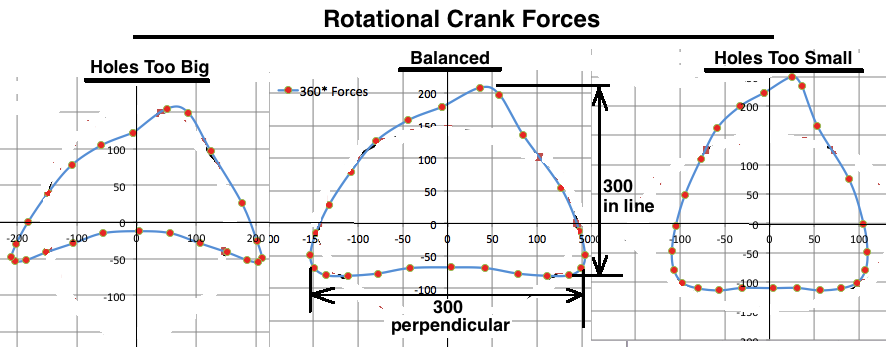 Click here to read why I don't recommend using the balance factor method. I
had two different 55cc engines
using different cylinders and pistons. One was with piston port intake
and the other was reed valved. The results I got testing those, along
with online calculators for upper piston assembly inertia force and the
centrifugal force of the counter balance is what I based my old theory
of
balancing on. The piston port engine was way off in balance, and the
other was perfectly balanced. Using it as a base point I developed an
Excel file for calculating the rotational forces on the crankshaft
which allows you to input different counter-balance hole sizes till the
numbers are right. In calculating the offsetting centrifugal force of the imbalanced flywheel we treat the weight removed by the flywheel holes as an additional weight because on the opposite side of the flywheels there exists that additional weight. For example, if you removed the flywheel and put it on two weight scales you will see that the non-holed side has weight in excess of the holed side equal to the actual weight removed when the holes were made. So we use that "missing" weight to make the centrifugal force calculations. 1st test: 2nd
test: In
figuring the counter balance weight it's important to include
everything that
would affect it. As example: my flywheel came with two 11.5mm diameter
holes through both flywheels. The stainless steel there removed adds up
to 50 grams. The conrod pin added 3.3 grams after the weight of the
conrod pin holes weight were subtracted from it. Its weight was only
calculated using the steel weight calculator listed below, not
measured. The part of the conrod that is around the bearing, and the
bearing itself, weigh around 30 grams. The centrifugal force has to be
figured at the distances of 19mm of the conrod pin, 36mm of the
additional
balance hole, and the distance of the two counter balance holes. 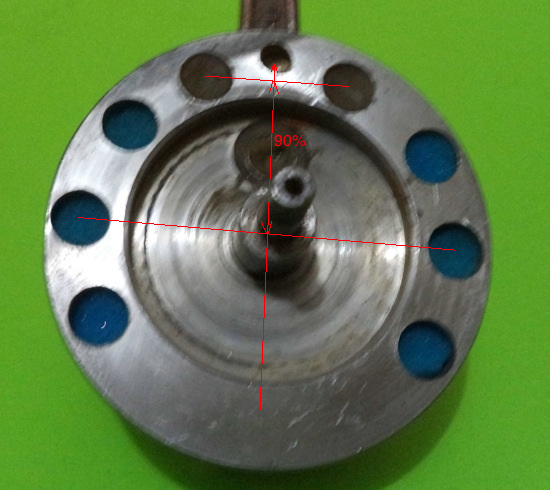 Here are two useful online calculators. The second one may be needed if you use two different sized drill bits in the same hole with the largest bit only drilling a portion of the full depth. You can do that if you need a certain amount of weight removed but you don't have the right size drill bit. centrifugal force calculator (don't enter linear speed. change m to mm, change kg to grams, change N to lbf) steel weight calculator (multiply kgs by 1000 to get grams)Here
is a picture of my crank assembly with an additional balancing hole
just above the conrod pin. The 6 blue holes are lightening holes for
better acceleration (although I wouldn't recommend any more than 4 if
the bike is for street use). The blue is foam filling half the hole.
The ends of each hole were later filled with JBWeld. I used foam just
to reduce the amount of expensive JBWeld used. The conrod hole and two
factory balance holes are already filled with JBWeld for increased
crankcase compression (which isn't important unless your engine revs to
9000 or more).  Concerning determining the weight of the lower conrod bearing and the part of the conrod that is around the bearing: I figured that by dipping the two into a measured amount of water and seeing how many cc (ml) they raise the water level and then multiplied their ratio by the total weight. My 48cc rod end with bearing had an equivalent 30 grams. You can drill extra balance holes
with any good electric drill although it's a bit tough. Much easier to
take it to a machine shop and let them put it on a drill press. Also
the holes can be drilled at the TDC or BDC location of the crank wheels
without even taking it out of the crank cases. Just put duct tape on
the crank wheels (after cleaning them with alcohol) to keep metal
shavings from going into the crankcase, and then keep the crank in
correct position by using vise grips on the primary gear above and
below where it meshes with the clutch gear. You can measure from
halfway through the angled drill bit tip and mark the drill bit at the correct
distance with black electrical tape wrapped around it. That way you have a visual
reference while drilling. Here's one of my cranks (Suzuki AX100) with holes drilled 180 degrees from the crank pin: 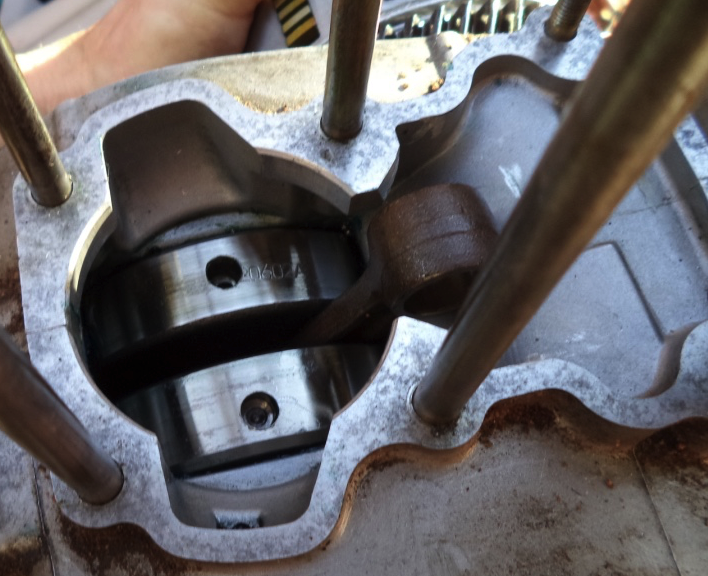 DIY Crank Balance Test: 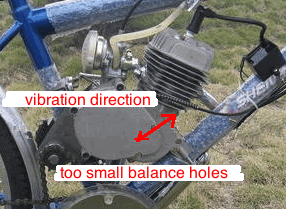 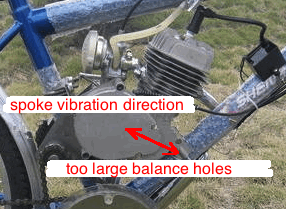 Click here to read more about my spreadsheet which can be used to calculate the size of counter balance holes needed in any crank. |